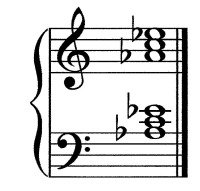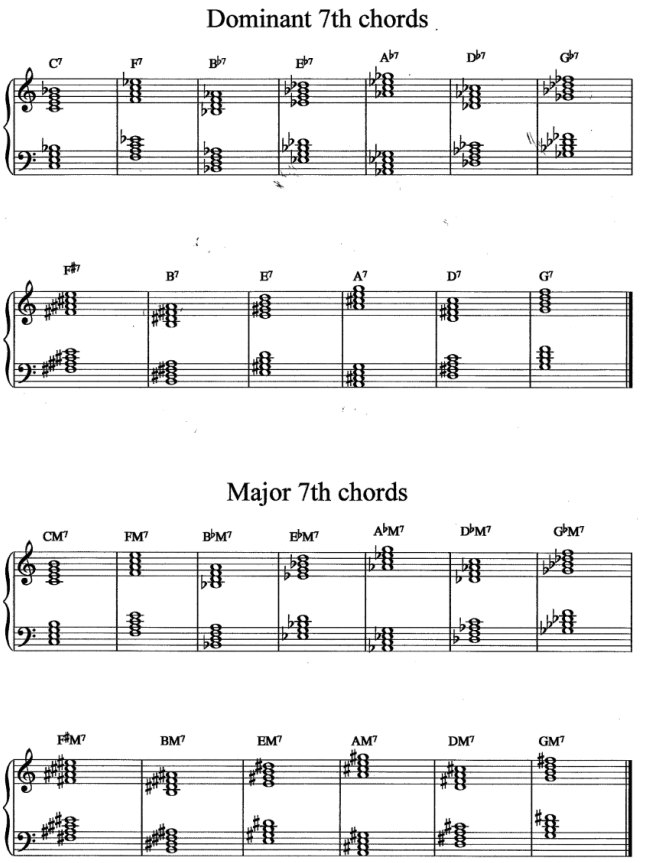The purpose of this website: helping you learn to play the piano. Building a strong foundation of piano-playing skills will lead to a lifetime of piano-playing joy.
Chord Finder:
Learn the basic chords, and you can find them all
In your search for a specific chord, you can use a chord finder, or you can be the chord finder. Just keep looking up chords on the computer/online-chord-finding dictionaries, and you will always need the help. On the other hand, if you really learn and master the basic triads ("Triad" refers to a 3-note chord), consisting of 12 majors and 12 minors and 12 diminished, you will have the foundation laid for figuring out any chord you might need.

Piano Chords, along with the piano scales, are the basic building blocks of most piano music. Learning the chords develops your keyboard awareness, and enhances your understanding of the music you read, memorize, compose, or improvise.
Once you have become familiar with the 12 major triads and the 12 minor triads and the 12 diminished triads in root position, you can begin learning how to invert them, voice them differently, spread them out, use them in melodies, and create accompaniment patterns with them. Some pop music, and just about all jazz music, calls for adding extra notes to the basic triads (6ths, 7ths, 9ths, 11ths, 13ths), but you must first know your triads, inside and out. You will also find the triads handy for analyzing piano pieces you might be reading or memorizing. Thus the process of learning how to play the music (and memorize it) becomes much easier than if you had no such knowledge of chords.

Here, you will not find any fancy, technology-aided chord finder (sorry), but a comprehensive list of all the triads (excluding augmented triads, which are rare, but easy to make by simply raising the fifth of a major triad by a half step). You may use the list just to look up certain chords, but I would encourage you to take the time to really learn them all and play them on the piano, regularly. They are as important to the pianist as the alphabet is to the writer/reader.
For a more complete understanding of how to build your piano-playing foundation, read
For the most direct, organized, and progressive path to learning to play the piano, start
the Piano Skills Foundation series of piano lessons.
(Advertisement)
Chord Finder: The Common Chords By Root
A Chords
A-flat Chords
B Chords
B-flat Chords
C Chords
C-sharp Chords
D Chords
D-flat Chords
D-sharp Chords
E Chords
E-flat Chords
F chords
F-sharp Chords
G Chords
G-flat Chords
G-sharp Chords
Major & Minor Triads: "Keyboard Image"
To find the major and minor triads grouped according to keyboard image, go to "keyboard chords I" (major triads), or "keyboard chords II" (minor triads).
Major & Minor Triads: Chromatically
Once you've learned the chords in these groups, the next step is to play them chromatically: up and down in half-steps. Thus, you will find the same major and minor triads listed in half steps if you go to "Major & Minor Triads".
Once you know these triads in root position and can play them proficiently up and down in half-steps for at least one octave, try playing them around the circle of 4ths. This will not only increase your knowledge and feel for each chord, but will improve your keyboard awareness.
To learn more about developing keyboard awareness, go from "Piano Chords" to "Free Piano Lessons".
Diminished Triads
For a page devoted exclusively to diminished triads, go to "Diminished Chords".
-click here for more about chords-
Return from "Chord Finder" to "Free Piano Lessons".

If you want to see a blueprint for a successful piano journey...
read
"Piano Player... You"
A guide to building a solid and complete piano-playing foundation.
-Click here to learn more about this e-book-
If you would like a step-by-step guide to help you on your piano journey...
start working through
"The Piano Skills Foundation" piano lessons
-Click here to learn more about this piano course-
Looking for some piano music?
I have found Sheet Music Plus to be a fantastic resource for piano books & other materials. And they have instant digital downloads for thousands of individual pieces.
3 Ways To Support This Website
If you enjoy using true-piano-lessons.com and would like to help support it:
1. Buy the ebook, "Piano Player... You"
2. Purchase "Piano Skills Foundation"
3.Donation



